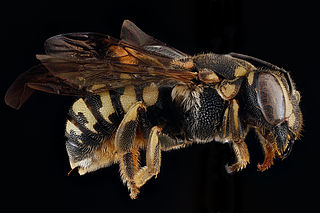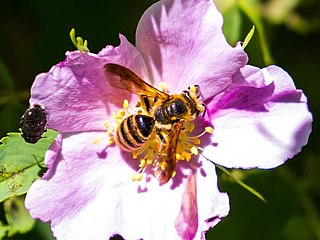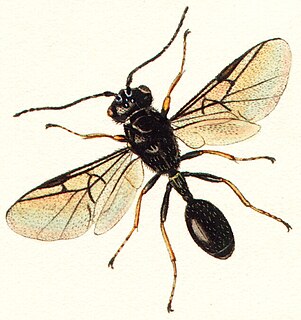
Mason bee is a name now commonly used for species of bees in the genus Osmia, of the family Megachilidae. Mason bees are named for their habit of using mud or other "masonry" products in constructing their nests, which are made in naturally occurring gaps such as between cracks in stones or other small dark cavities. When available, some species preferentially use hollow stems or holes in wood made by wood-boring insects.

Osmia bicornis, synonym Osmia rufa, is a species of mason bee, and is known as the red mason bee due to its covering of dense gingery hair. It is a solitary bee that nests in holes or stems and is polylectic, meaning it forages pollen from various different flowering plants. These bees can be seen aggregating together and nests in preexisting hollows, choosing not to excavate their own. These bees are not aggressive; they will only sting if handled very roughly and are safe to be closely observed by children. Females only mate once, usually with closely related males. Further, females can determine the sex ratio of their offspring based on their body size, where larger females will invest more in diploid females eggs than small bees. These bees also have trichromatic colour vision and are important pollinators in agriculture.

Hoplitis anthocopoides is a species in the family Megachilidae, in the order Hymenoptera . The distribution range of Hoplitis anthocopoides includes Africa, Europe, Northern Asia, and North America.
Osmia glauca is a species in the genus Osmia, in the family Megachilidae . It is found in North America.
Stelis perpulchra is a species of insect in the family Megachilidae. It is found in Central America and North America.
Anthidiini is a tribe of insects in the family Megachilidae. There are at least 40 genera and 840 described species in Anthidiini. There is strong evidence that the tribe is monophyletic.
Lithurgopsis is a genus of northern cactus woodborers in the family Megachilidae. There are at least nine described species in Lithurgopsis.

Dianthidium simile is a species of leafcutter, mason, and resin bees in the family Megachilidae. It is found in North America.
Dianthidium is a genus of leafcutter, mason, and resin bees in the family Megachilidae. There are at least 20 described species in Dianthidium.
Stelis interrupta is a species of leafcutter, mason, and resin bees in the family Megachilidae. It is found in North America.

Stelis is a genus of kleptoparasitic bees in the family Megachilidae. There are at least 100 described species in Stelis.
Stizoides foxi, or Fox's stizoide, is a species of sand wasp in the family Crabronidae. It is found in Central America and North America.

Osmiini is a tribe of leafcutter, mason, and resin bees in the family Megachilidae. There are about 19 genera and at least 1,000 described species in Osmiini.

The golden-haired miner bee is a species of miner bee in the family Andrenidae. The female bees are 8 to 10 mm in length, and males are 6 to 9 mm long. It is found in the western United States, and is relatively rare outside California. It looks very similar to the death camas miner bee but is smaller.
Lasioglossum olympiae is a species of sweat bee in the family Halictidae.

Coelioxys banksi is a species of leafcutter, mason, and resin bees in the family Megachilidae.
Sphecodes mandibularis is a species of sweat bee in the family Halictidae.
Perdita rivalis is a species of mining bee in the family Andrenidae. It is found in North America.

Heloridae is a family of wasps in the order Hymenoptera known primarily from fossils, and only one extant genus, Helorus, with 12 species found worldwide. Members of Helorus are parasitic on green lacewings.

Osmia montana is a species of hymenopteran in the family Megachilidae. It is found in North America.









